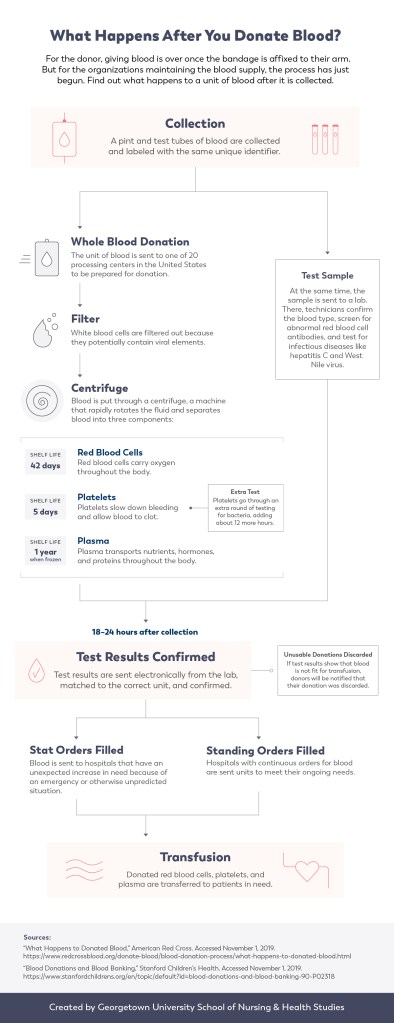Understanding Blood Donations

Like food and water, blood is a valuable resource during an emergency. The Department of Health and Human services recognizes blood as one of the safety and security components (PDF, 72 KB) within the Emergency Support Function of the National Security Framework. After 9/11, a task force was set up to create a crisis response plan specifically addressing blood during times of emergency.
Regular needs provide their own challenges, though. About 30,000 blood donors are needed each day to meet average demand (PDF, 340 KB), according to America’s Blood Centers. In May 2019, the Red Cross had only six units of type O blood available for every 100,000 people — less than half of what is needed daily.
As Senior Vice President of Donor Services at the Red Cross, Paul Sullivan is familiar with the gap between blood supply and demand. A big part of the challenge, he said, is getting people to care enough to show up and donate. For him, though, the impact is pretty clear.
“In other parts of charity or giving, there’s the philanthropic donor who can give millions of dollars to support a local cause or foundation,” he said. “In blood donation, each person can help one other person and that’s a profoundly positive, profoundly powerful concept.”
How Does Blood Donation Work?
According to The American Society of Hematology, blood banking is “the process of collecting, separating, and storing blood.” It also includes typing and testing blood. Every hospital has a blood bank where it stores blood, but not every hospital has the infrastructure to also collect donations.
That’s why organizations like the Red Cross and America’s Blood Centers, a coalition representing blood donation centers around the country, fulfill orders from hospitals. That means a donation from Seattle can help a patient in Indianapolis.
Ruth Sylvester, Director of Regulatory Services at America’s Blood Centers, said that blood is constantly moving from location to location. “It happens every day. We ship blood all over the country,” she said. “There are some areas that are able to over-collect, and they export blood to areas where they just aren’t able to meet their needs.”

After a whole blood donation is made, a test sample is sent to a lab, and the donated unit is sent to a processing center. While the sample is tested for infections, the unit is separated into red blood cells, platelets, and plasma. The test results are confirmed before donations are shipped to hospitals in need.
What Is in a Blood Donation?
There are some general trends that can describe the demand for blood — type O positive is always needed because it’s the most common blood type and therefore needs to be transfused the most. But there are different types of blood donations because there are different parts of blood.
*Note: Blood donation eligibility and requirements are federally regulated and do not vary from location to location. To find out if you are eligible to donate, visit The Red Cross Eligibility Requirements or see below.
Whole Blood Donation
The most common type of donation, whole blood contains all parts of the blood. It can be separated later, making it the most flexible.
Why it is used:
Blood loss due to trauma or surgery
Shelf life:
21 or 35 days, depending on the anticoagulant used
Highest demand for:
All blood types
Red Blood Cells
The primary function of red blood cells is to carry oxygen to all parts of the body.
Why it is used:
Blood disorders, bleeding from trauma, surgery, cancer treatment
Shelf life:
42 days
Highest demand for:
O positive, O negative, A negative, and B negative
Platelets
Platelets allow blood to clot and slow down bleeding.
Why it is used:
Surgery, cancer treatment, sickle cell anemia treatment, transplants
Shelf life:
5 days
Highest demand for:
A positive, A negative, B positive, O positive, AB positive, and AB negative
Plasma
Plasma makes up the majority of blood and is responsible for transporting nutrients, hormones, and proteins throughout the body.
Why it is used:
Trauma and emergency
Shelf life:
1 year
Highest demand for:
AB positive and AB negative
Why is donating blood important? Part of the messaging around blood donation is educating potential donors on the effect their contribution has. The phrase “emergency blood transfusion” can conjure images of accidents and sudden blood loss. Dr. Meghan Delaney, Director of Transfusion Medicine at Children’s National Hospital in Washington, DC, explained that transfusion encompasses so much more than people may realize.
“Anytime you put blood through a circuit that’s not a human body, like the plastic tubing, it causes problems,” she said.
How Blood is Used
67%
for medical conditions including anemia, cancer, and blood disorders
27%
for surgery, including cardiac surgery and emergency surgery
6%
for blood loss after childbirth
Source: “How Blood Is Used,” 2014, National Health Service Blood and Transplant.
For example, anytime a patient is on ECMO (extracorporeal membrane oxygenation), a machine that acts as an artificial lung, blood is pumped in and out of the body.
“One of the patients that I’ve seen in my career had a near-drowning event and got hundreds of units of blood product, and he actually walked out of the hospital alive,” recalled Delaney.
“People don’t think that blood could be used or needed in those kinds of situations.”
Educating potential donors on the importance of blood donation is a necessary part of encouraging more participation. To learn more about blood donation, its uses, and the need for more consistent giving, consult the “Further Reading” section below.
Further Reading
Citation for this content: Nursing@Georgetown, the online DNP program from the School of Nursing & Health Studies


